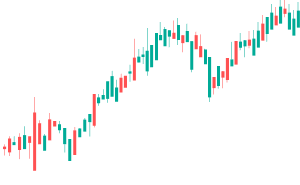The Hammer and Hanging Man patterns both consist of a single candlestick. They have rather long lower shadows and small real bodies which are located at the very top of the daily trading range, or somewhere near. They are sometimes called the special cases of the Tonbo/Takuri candlesticks.
The Hammer was named so because it “hammers out” the bottom. It occurs in a downward trend. The Japanese word for a hammer (tonkachi) also means the ground or the soil. Another candlestick similar to the Hammer is called the Takuri line. This Japanese word means climbing a rope. The Takuri line pattern has a lower shadow three times the length of the body, while the minimum length of the Hammer’s shadow is only twice the length of the candlestick’s body.
As for the Hanging Man, one can see it at the trend top. Its name comes from the fact that this candlestick reminds somewhat of a hanging man.
If we look in detail at the Hammer pattern, we can see the following: the market is in a downward trend, thus reflecting certain bearishness. As the market opens, the price plunges rapidly. Then it starts to pick up, and the market finally approaches the session highs. If the closing price is higher than the market opening price, then the candlestick’s body is colored white. This situation tends to favor the bullish sentiment even more. It can also be confirmed by a higher opening price with an even higher closing price on the next trading day.
Speaking of the Hanging Man, the market is influenced by bulls because of the upward trend. In order for the Hanging Man to appear, the price must fall lower than where it opened. Then it should climb and then close near the highest marks. That is the moment when one can see a long lower shadow which shows how much the prices might decline. If the market opens lower the next day, then many traders who hold long positions would be looking for an opportunity to sell.
The features that enhance the signal coming from the Hammer or the Hanging Man are a rather long lower shadow, no upper shadow (almost Doji), and a strong previous trend as well as a body color that reflects the sentiment opposite to the previous trend. With all of these features combined, the Hammer changes into a Takuri candlestick. Takuri lines are usually much more bullish compared to the Hammer pattern.
The body color of the Hanging Man and the Hammer can convey a great deal of information. The Hanging Man pattern with a black body is more bearish than the one with a white body. Likewise, the Hammer pattern with a white body would be more bullish than the one whose body is colored black.
When the Hammer or the Hanging man appears, it is important to wait for some confirmation, which may simply be the action of the next day opening. However, it would be much better to wait for a confirming closure. If the Hammer appears, the price should close even higher on the following day. In this case, you can take a bullish position.
The Hammer and the Hanging Man patterns both consist of just one candlestick, so they cannot be divided any further.
As for related patterns, the Hammer and Hanging Man patterns are considered to be special cases of the so-called Dragonfly Doji. In most cases, it would be more bearish than the Hanging Man.
The IFX Hammer and Hanging Man indicator will help you find this pattern on a chart. Just add the downloadable file to your MetaTrader indicators folders, and this indicator will identify the Hammer and Hanging Man patterns automatically.
